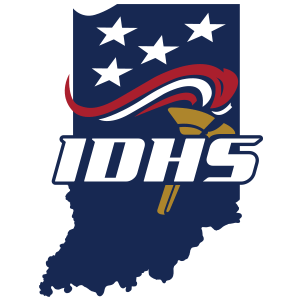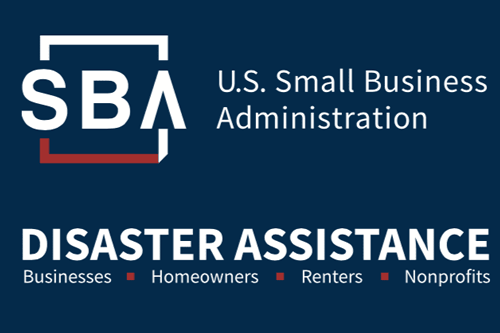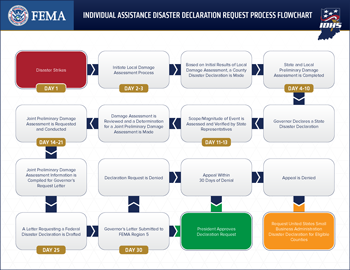News/Updates
SBA Disaster Loans Available
For Storms and Tornado in May 2024
Businesses and residents of Franklin, Dearborn, Decatur, Fayette, Ripley, Rush and Union counties affected by the severe storms and tornado that occurred May 7, 2024, are eligible to apply for low-interest disaster loans from the U.S. Small Business Administration. The filing deadline to return applications for physical property damage is July 22. The deadline to return economic injury applications is Feb. 24, 2025. Visit sba.gov/disaster to apply.
For Storms and Tornadoes in March 2024
Businesses and residents of Randolph, Delaware, Henry, Jay and Wayne counties affected by the severe storms and tornadoes that occurred March 14, 2024, are eligible to apply for low-interest disaster loans from the U.S. Small Business Administration. The deadline to return economic injury applications is Dec. 30. Visit sba.gov/disaster to apply.
For Ice Jams and Flooding in Lake County
Businesses and residents of Lake County affected by the ice jams and flooding that occurred Jan. 15-25, 2024, are eligible to apply for low-interest disaster loans from the U.S. Small Business Administration. The filing deadline to return applications for physical property damage has expired, but the deadline to return economic injury applications is Dec. 13. Visit sba.gov/disaster to apply.
About Individual Disaster Assistance
The Recovery Section administers Individual Assistance as provided under federal law during a Presidential Declared Disaster (PL93-288 as amended by PL100-700). The Other Needs Assistance (ONA) Program is part of the FEMA Individuals and Households Program (IHP). These programs provide disaster assistance in the form of grants for home repair, rental assistance and personal property lost or damaged during the disaster for homeowners and renters.
The ONA program works closely with the American Red Cross, Salvation Army, local unmet needs groups, U.S. Small Business Administration (SBA), National Flood Insurance Program (NFIP) and various state and local agencies.
Overview of the Individuals and Households Program (IHP)
- Individual Assistance (IA)
Purpose
When disasters take place, the FEMA Individuals and Households Program (IHP) provides grant money and services to people in the declared disaster area when the losses are not covered by insurance and property has been damaged or destroyed. The Individuals and Households Program and the Other Needs Assistance will not put you where you were before the disaster but can get you back to a safe and sanitary condition.
Limitations
IHP will not cover all of your losses from damage to your property (home, personal property, household goods) that resulted from the disaster. IHP is not intended to restore your damaged property to its condition before the disaster. In some cases, IHP may only provide enough money, up to the program limits, for you to return to a livable home.
IHP does not cover business-related losses that resulted from the disaster. However, you may apply to the U.S. Small Business Administration (SBA) for a Business Disaster Loan to help provide financing to get your business losses covered.
By law, IHP will not provide money to you for losses that are covered by your insurance.
While some money is available through IHP, most disaster aid from the federal government is in the form of loans from the SBA, the disaster loan program that must be repaid. Applicants to IHP may be required to seek help from SBA first, before being considered for certain types of IHP help. If you are required to apply for an SBA disaster loan and do not complete the process, you may not be eligible for any further assistance through FEMA. You do not have to submit an SBA loan application to be considered for FEMA rental assistance.
- Types of Assistance
Purpose
When disasters take place, the FEMA Individuals and Households Program provides grant money and services to people in the declared disaster area when the losses are not covered by insurance and property has been damaged or destroyed. The Individuals and Households Program and the Other Needs Assistance will not put you where you were before the disaster but can get you back to a safe and sanitary condition.
Types
- Temporary Housing (a place to live for a limited period of time): Money is available to rent a different place to live, or a government-provided housing unit when rental properties are not available. You may receive rental assistance through FEMA for up to 18 months as long as you demonstrate a continued need for financial temporary housing assistance. You may be provided additional assistance if FEMA’s assistance program is still open, you have not yet reached the financial assistance maximum grant and FEMA finds that you have a continued need.
- Repair: Money is available to homeowners to repair damage from the disaster that is not covered by insurance. The goal is to make the damaged home safe, sanitary and functional.
- Replacement: Grant money is available to homeowners to replace their home destroyed in the disaster that is not covered by insurance. The goal is to help the homeowner with the cost of replacing the destroyed home.
- Permanent/Semi Permanent Housing Construction: Direct assistance or money for the construction of a home. This type of assistance is made available only in insular areas or remote locations specified by FEMA, where no other type of housing assistance is possible.
- Other Needs Assistance (ONA): Grant money is available for necessary expenses and serious needs caused by the disaster. This includes medical, dental, funeral, personal property, transportation, moving and storage and other expenses that are authorized by FEMA.
- Do It Yourself (DIY) Recovery Toolbox
- Damage Assessment Toolbox
- Damage Assessment Impact Statement Assistance
- Damage Assessment Matrix - FEMA
- Damage Assessment Street Sheet - FEMA
- Damage Assessment Street Sheet - SBA
- Disaster Impact Assessment Form
- EMA Pre-Damage Assessment Request Checklist
- FEMA Disaster Process Timeline and Steps
- IDHS Damage Assessment Safety Overview
- Just-In-Time Training: FEMA
- Just-In-Time Training: SBA
- Post-Event Damage Assessment Narrative Input Template
- Post-Event Damage Assessment Procedure
- Preliminary Damage Assessment Field Guide
Damage Assessment Procedures for Individual Assistance
- Situation is monitored by IDHS/EOC and has close contact with the county EOC.
- Once damaged areas are identified, surveyed and the results reported to IDHS, the county is contacted for a Preliminary Damage Assessment (PDA) verification survey with the county and IDHS officials.
- If enough damage was found and enough damage has been verified in the state to be significant, then county, state and federal agencies conduct a Joint Preliminary Damage Assessment (JPDA).
- FEMA will evaluate the information gathered and verified during the JPDA. If the verified damage and impacts warrant federal assistance, the governor sends a letter to the President requesting a disaster declaration based on the JPDA findings.
- Individual Assistance Program (IHP) Toolbox
- Individual and Households Program Sequence of Delivery
- Help After a Disaster
- Individual Assistance Fact Sheet
- Crisis Counseling
- Funeral Assistance
- Transitional Sheltering
- National Flood Insurance Program Fact Sheet
- US Small Business Administration – USSBA
- Training Information - Introduction to Individual Assistance


